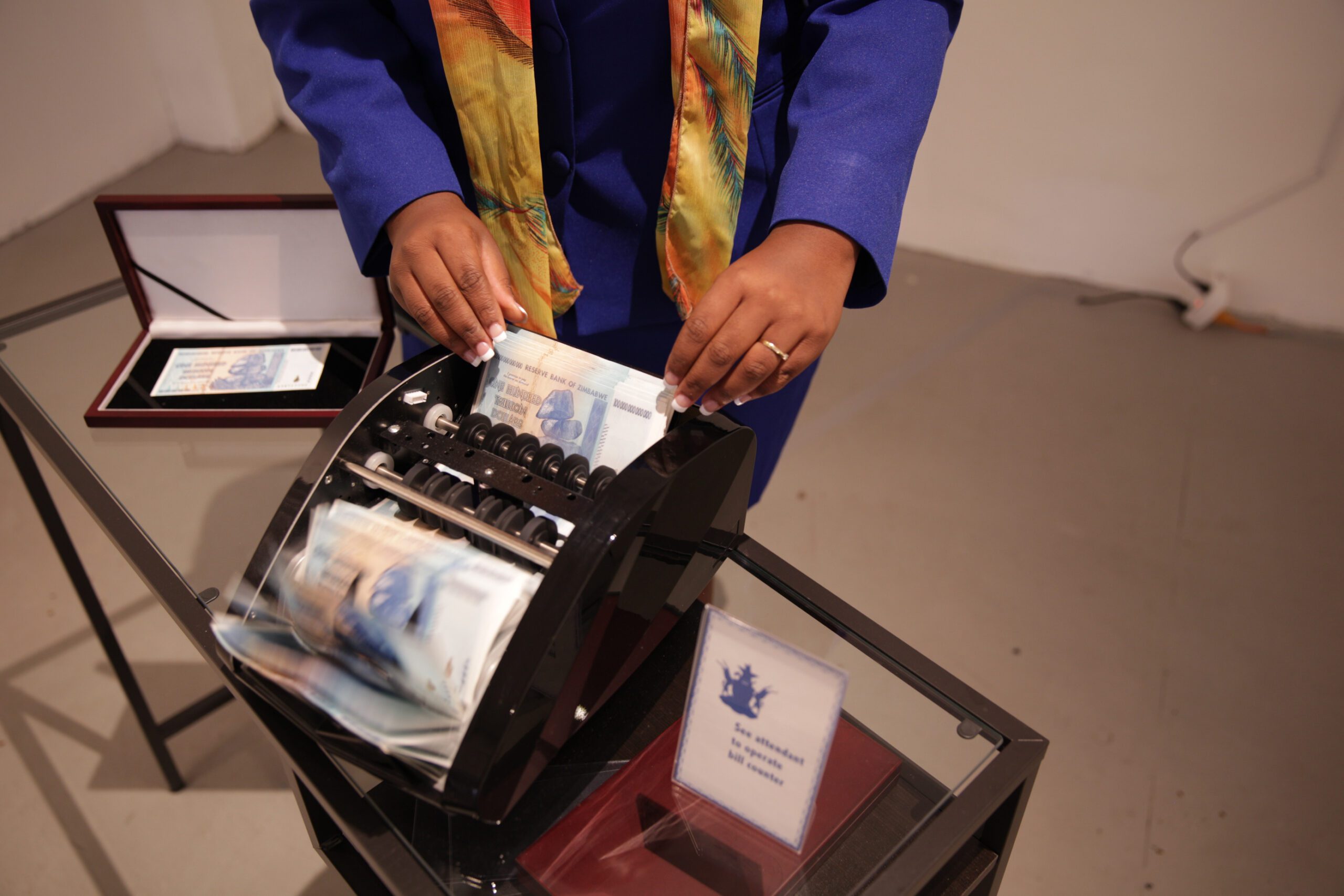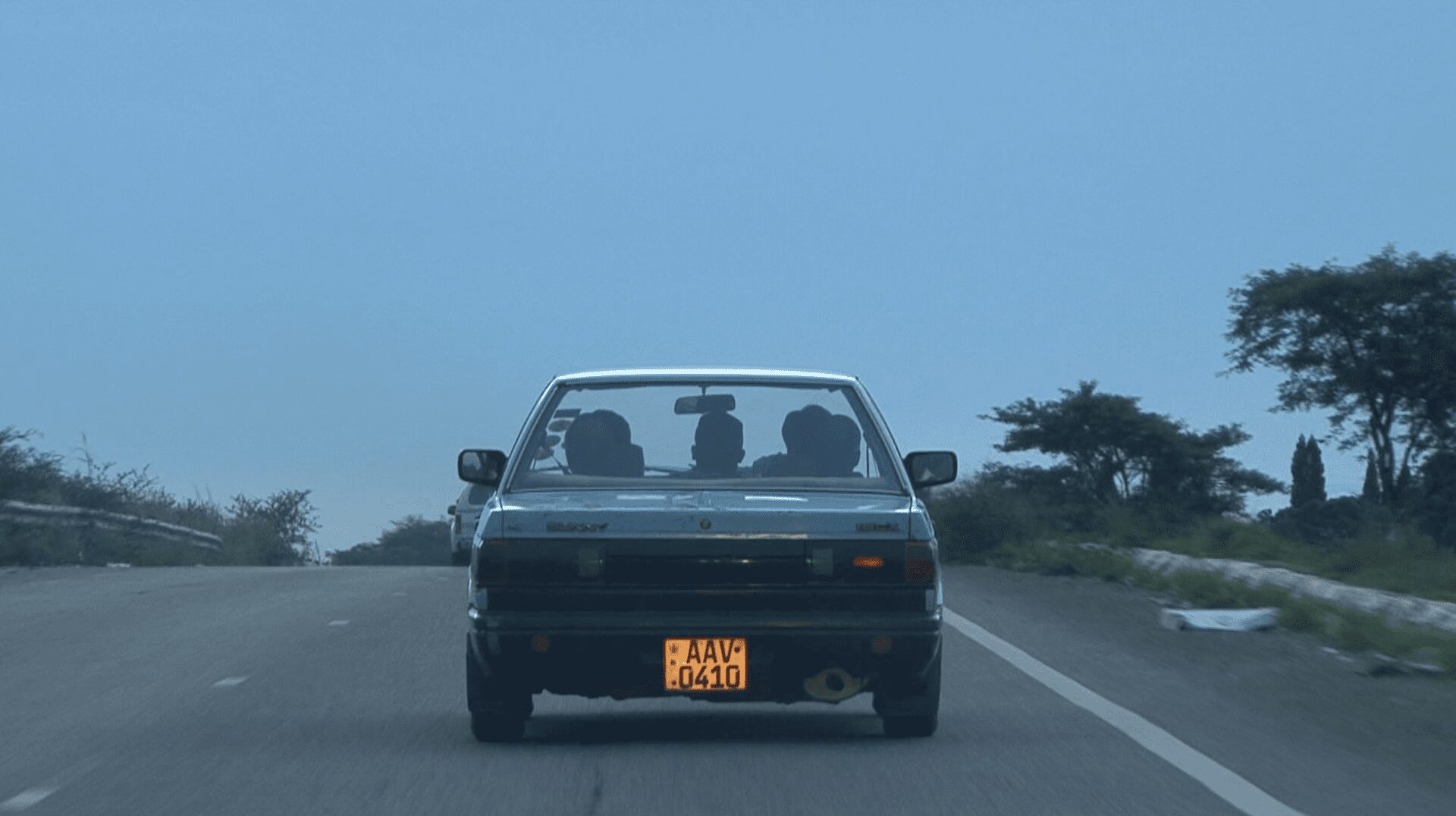There are contextual parallels between Brazilian and Zimbabwean politics, says artist Lucia Nhamo, who recently completed a residency in Salvador de Bahia.

Lucia Nhamo, 100, 000, 000, 000, 000..., 2014. Installation detail. Currency, money counter, Zero Halliburton Centurion case, HD video, live performance. Courtesy of the artist
.
C&: Tell us a bit about your multimedia artistic practice. How did it all start?
Lucia Nhamo: My interest in video began at Wellesley College in Boston where I did my bachelor’s degree. My drawings became increasingly sequential and I had the urge to create movement.
A conceptually based practice lends itself to interdisciplinary investigation, so during my time at Carnegie Mellon University (Pittsburgh) pursuing my MFA, I expanded my interest in multiplicity through an exploration of printmaking, sculpture, and animation.

Lucia Nhamo, Free Fall: A Chronology of the Zimbabwe Dollar, 2015. Installation detail. 3-channel video animation, custom-packaged peanuts, LED screen, glass case, defunct currency, video, live performance. Courtesy of the artist
C&: Your video Portrait of a Decade: Zimbabwe 1999–2009, was shown at the 10th edition of the Bamako Encounters – African Biennale of Photography in 2015 and won an award there. Can you talk about your inspiration for this project and how it came into being?
LN: I made Portrait of a Decade in 2011. It felt like a time when, as Zimbabweans, we could collectively take a breath and reflect on the last decade of socio-economic upheaval. Through my mother’s personal recollections of daily experiences during this time, the film meditates on the effect national politics have on personal perceptions of reality. The viewer is only allowed to see ordinary people’s feet and hands as they perform daily rituals, in contrast to archival footage of government officials that shows faces and complete bodies. Donald Donham’s essay “Staring at Suffering: Violence as a Subject” has served as a blueprint for me in terms of thinking about alternative ways of representing trauma. He highlights our responsibility for contextualizing situations in ways that emphasize the complexities at play and reject an essentialist approach to the subject matter. The desire to resist sensationalism is what draws me to the work of Doris Salcedo. There is no melodrama in the representation of memory and loss in her work, which deals with the history and silent trauma of the disappeared in her homeland of Colombia.
C&: Socioeconomic aspects in the Zimbabwean context play a central role in your video Free Fall: A Chronology of the Zimbabwe Dollar. Why did you choose this subject?
LN: Though we officially stopped using the Zimbabwe dollar in 2009, it remains an ominous symbol of the dire economic realities that culminated in 2008. The question and threat of the “return of the Zim dollar” is a constant sense of foreboding that permeates day-to-day life while we walk the tightrope of economic instability and political precariousness. “It’s not politics, it’s life,” as Ngugi wa Thiong’o writes.
C&: Please share with us how you go about making such a multimedia installation. For instance, how do you work with the space?
LN: I start with a key element and then build an experience around it. The space you have to work in will always dictate the form and experience of the piece. With Free Fall, the key element was the three-channel video animation that was then mediated through a fictional airline. All the corresponding elements of the installation were employed towards that fiction: I performed as a flight attendant and served people peanuts; the peanuts came in custom packaging, with custom-printed napkins, served from an actual refurbished airline cart; the loop of the videos is dictated by the script of the boarding and in-flight safety announcements; there is a “duty free” area with display cases presenting defunct Zimbabwean currency.

Lucia Nhamo, Fuck You Chocolates, 2014. Installation detail. Solid chocolate casts of the artist’s hand. Courtesy of the artist
C&: In your exploration of counter-narratives, how important is the concept of memory and archives to you, also in terms of images?
LN: The serial anthology Whitechapel: Documents of Contemporary Art is the result of an editorial alliance between the MIT Press and the London-based Whitechapel Gallery. Introducing their edition on the archive, Charles Merewether writes that one of the chief characteristics of today’s society is the “increasing significance given to the archive.” Merewether’s concept of the “counter-archive” or the “counter-monument,” in which artists work through “a form of re-collection of that which has been silenced and buried,” informs my work as an artist. My urge to remember is tied up in the same principles that Avishai Margalit outlines in his book The Ethics of Memory, and is very much related to Derrida’s notion of archive fever as being a “searching for the archive right where it slips away.” Both personal and institutional archives continue to play a significant role in the work of practitioners who seek to problematize the past. When it comes to the impulse to create a range of alternatives in response to the dominant ideology, the counter-monument in particular sets memory in motion, verifying human experience while disrupting the one-way absolutes of authority.
C&: You just completed a residency in Salvador de Bahia, at the Vila Sul. Could you talk a little bit about your experiences there and the encounters that you had?
LN: Salvador was an incredible experience. Through the Goethe Institut, I had the opportunity to exhibit work and give a lecture during a performance festival run by the Escola de Belas Artes.
I gave a lecture on my work at the university, and for many, the contextual parallels of Brazilian and Zimbabwean politics were of particular resonance. I also embarked on a project centered around the gesture of unraveling: I wrapped myself up in 20 meters of white fabric and rolled down different ladeiras (slopes) and sites in the city. The video footage is wonderfully bizarre. It also prompted a delightful collaboration with performance artist Michelle Mattiuzzi, who rolled for me just outside the Lina Bo Bardi “Coaty” building in Pelourinho, the city’s historic center.

Lucia Nhamo, Portrait of a Decade: Zimbabwe 1999-2009, 2011. Video still. HD video. Courtesy of the artist
C&: What about your interest concerning the history of slavery in Africa and Brazil? How are you looking into this topic?
LN: Zimbabwe doesn’t share in this legacy of transatlantic trade in the way that Benin does, for example. So while this is an incredibly important aspect of global history, it’s not a topic of personal resonance for me. I have, however, drawn tremendous value from the sentiments and historical investigation of artists that I’ve met here in Brazil who deal with this subject as part of their practice. You also cannot deal with the very grave contemporary issues around race in Brazil without confronting the repercussions of that deeply fraught historical legacy.
C&: How do you see the relationship and connections between Lusophone artists and cultural producers from Africa and Latin America?
LN: Language has been such a huge element and mediator of my experience here in Brazil. It has opened up an entire new awareness of the Lusophone world. I’ve been thinking a lot about early Portuguese trade and influence in what we know today as Zimbabwe: the introduction of maize as our staple crop, for example, and the integration of the Portuguese early settlers. I’ve also resolved to
visit Mozambique. It’s right next door to us! I’m very much looking forward to an art-filled, in-depth experience that goes beyond the superficial tourist jaunt of beaches and shrimp.
Lucia Nhamo was awarded the Goethe/Lanchonete residency prize at Bamako Encounters in 2015. The Goethe Institut and Musagetes/ArtsEverywhere support the juried prize of a two- month residency for an artist from Bamako Encounters with Lanchonete.org in São Paulo. The residency prize is awarded to a female artist whose work broadens and/or challenges perspectives on contemporary African migrations.
Interview by Aïcha Diallo
More Editorial